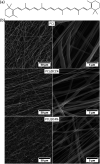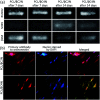β-Carotene: a natural osteogen to fabricate osteoinductive electrospun scaffolds
- PMID: 35540852
- PMCID: PMC9078714
- DOI: 10.1039/c7ra13237a
β-Carotene: a natural osteogen to fabricate osteoinductive electrospun scaffolds
Erratum in
-
Correction: β-Carotene: a natural osteogen to fabricate osteoinductive electrospun scaffolds.RSC Adv. 2018 Apr 25;8(28):15603. doi: 10.1039/c8ra90032a. eCollection 2018 Apr 23. RSC Adv. 2018. PMID: 35543990 Free PMC article.
Abstract
β-Carotene (βC) as a natural osteogenic material was incorporated in PCL electrospun mats to fabricate scaffolds for bone tissue engineering. These scaffolds successfully supported the attachment and proliferation of mesenchymal stem cells (MSCs). Seeded scaffolds were calcinated during 21 days of cell culture in a non-differential medium, which showed the osteodifferentiation of MSCs. Expression of RUNX2, SOX9, and osteonectin proved the osteoinductive effect of incorporated β-carotene on the differentiation of MSCs to osteoblasts without using any external osteogenic differential agent. However, the cells did not pass the early phase of osteogenesis and were still osteochondro-progenitor after 21 days of incubation. Thus, the fabricated fibrous scaffolds are potential candidates for direct bone tissue engineering.
This journal is © The Royal Society of Chemistry.
Conflict of interest statement
There are no conflicts of interest to declare.
Figures





Similar articles
-
Biodegradable bead-on-spring nanofibers releasing β-carotene for bone tissue engineering.Mater Sci Eng C Mater Biol Appl. 2018 Nov 1;92:800-806. doi: 10.1016/j.msec.2018.07.030. Epub 2018 Jul 20. Mater Sci Eng C Mater Biol Appl. 2018. PMID: 30184809
-
Osteoinductivity of polycaprolactone nanofibers grafted functionalized with carboxymethyl chitosan: Synergic effect of β-carotene and electromagnetic field.Int J Biol Macromol. 2020 May 1;150:152-160. doi: 10.1016/j.ijbiomac.2020.02.036. Epub 2020 Feb 6. Int J Biol Macromol. 2020. PMID: 32035957
-
Preparation of poly(ethylene glycol)/polylactide hybrid fibrous scaffolds for bone tissue engineering.Int J Nanomedicine. 2011;6:3065-75. doi: 10.2147/IJN.S25297. Epub 2011 Nov 30. Int J Nanomedicine. 2011. PMID: 22163160 Free PMC article.
-
Osteogenic differentiation of mesenchymal stem cells on pregenerated extracellular matrix scaffolds in the absence of osteogenic cell culture supplements.Tissue Eng Part A. 2010 Feb;16(2):431-40. doi: 10.1089/ten.TEA.2009.0583. Tissue Eng Part A. 2010. PMID: 19863274 Free PMC article.
-
Osteogenic Differentiation of MSCs on Fibronectin-Coated and nHA-Modified Scaffolds.ASAIO J. 2017 Sep/Oct;63(5):684-691. doi: 10.1097/MAT.0000000000000551. ASAIO J. 2017. PMID: 28234642
Cited by
-
Enhanced Adipose Mesenchymal Stem Cells Proliferation by Carboxymethyl-Chitosan Functionalized Polycaprolactone Nanofiber.Iran Biomed J. 2020 Jul;24(4):236-42. doi: 10.29252/ibj.24.4.236. Epub 2020 Feb 12. Iran Biomed J. 2020. PMID: 32306721 Free PMC article.
-
Solution-Based Processing for Scaffold Fabrication in Tissue Engineering Applications: A Brief Review.Polymers (Basel). 2021 Jun 22;13(13):2041. doi: 10.3390/polym13132041. Polymers (Basel). 2021. PMID: 34206515 Free PMC article. Review.
-
Osteoporosis: Causes, Mechanisms, Treatment and Prevention: Role of Dietary Compounds.Pharmaceuticals (Basel). 2024 Dec 16;17(12):1697. doi: 10.3390/ph17121697. Pharmaceuticals (Basel). 2024. PMID: 39770539 Free PMC article. Review.
-
Simple Electrospinning Method for Biocompatible Polycaprolactone β-Carotene Scaffolds: Advantages and Limitations.Polymers (Basel). 2024 May 11;16(10):1371. doi: 10.3390/polym16101371. Polymers (Basel). 2024. PMID: 38794563 Free PMC article.
-
Carboxymethyl Chitosan-Functionalized Polyaniline/Polyacrylonitrile Nano-Fibers for Neural Differentiation of Mesenchymal Stem Cells.Appl Biochem Biotechnol. 2023 Dec;195(12):7638-7651. doi: 10.1007/s12010-023-04526-6. Epub 2023 Apr 18. Appl Biochem Biotechnol. 2023. PMID: 37071298 Free PMC article.
References
LinkOut - more resources
Full Text Sources
Research Materials

